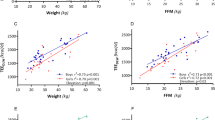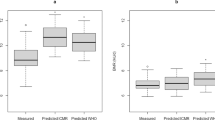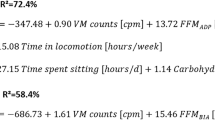Abstract
Objective:
To validate a physical activity questionnaire for adolescents (PAQA) adapted from the International Physical Activity Questionnaire (IPAQ).
Design:
Energy expenditure was measured during a 14-day period with doubly labelled water (DLW). PAQA was administered as an interview at the end of the period, asking for physical activity in school, during transportation and leisure-time, during a habitual week. Energy expenditure (EEPAQA) was calculated as the product of total physical activity+sleep and predicted resting metabolic rate, and was compared to energy expenditure from DLW (EEDLW), thermic effect of feeding excluded.
Setting:
Participants were recruited from grade 9 in a compulsory school in Göteborg, Sweden. All data were collected at school, and distribution of DLW and measuring of resting metabolic rate were performed at Sahlgrenska University Hospital.
Subjects:
A total of 33 adolescents (16 girls, 17 boys) 15.7 (0.4) y performed all measurements.
Results:
For the whole group, PAQA underestimated energy expenditure by 3.8 (1.7) MJ (P<0.001). There was a strong correlation (r=0.62, P<0.001) between EEPAQA and EEDLW, but not for boys (r=0.42, P=0.090) and girls (r=0.33, P=0.22) separately.
Conclusions:
PAQA is not able to predict energy expenditure in Swedish adolescents, largely explained by the amount of unreported time. The ability to rank adolescents energy expenditure is questioned because of the gender effect, although we found a strong correlation for the whole group.
Sponsorship:
Ingabritt and Arne Lundberg Foundation.
This is a preview of subscription content, access via your institution
Access options
Subscribe to this journal
Receive 12 print issues and online access
$259.00 per year
only $21.58 per issue
Buy this article
- Purchase on Springer Link
- Instant access to full article PDF
Prices may be subject to local taxes which are calculated during checkout


Similar content being viewed by others
References
Ainsworth BE, Haskell WL, Whitt ML, Irwin ML, Swartz AM, Strath SJ, ÓBrien WL, Bassett Jr DR, Schmitz KH, Emplaincourt PO, Jacobs DR & Leon A (2000): Compendium of physical activities: an update of activity codes and MET intensities. Med. Sci. Sports. Exerc. 32 (Suppl. 9), 498S–504S.
Allison DB, Paultre F, Goran MI, Poehlman ET & Heymsfield SB (1995): Statistical considerations regarding the use of ratios to adjust data. Int. J. Obes. Relat. Metab. Disord. 19, 644–652.
Altman DG (1991): Practical Statistics for Medical Research. London: Chapman & Hall.
Bland JM & Altman DG (1986): Statistical methods for assessing agreement between two methods of clinical measurement. Lancet 1, 307–310.
Booth M (2000): Assessment of physical activity: an international perspective. Res. Q. Exerc. Sport 71, 114–120.
Booth ML, Okely AD, Chey T & Bauman A (2002): The reliability and validity of the Adolescent Physical Activity Recall Questionnaire. Med. Sci. Sports Exerc. 34, 1986–1995.
Cole TJ, Belizzi MC, Flegal KM & Dietz WH (2000): Establishing a standard definition for child overweight and obesity worldwide: international survey. BMJ 320, 1–6.
Craig CL, Marshall AL, Sjöström M, Bauman AE, Booth ML, Ainsworth, BE, Pratt M, Ekelund U, Yngve A, Sallis J & Oja P (2003): International Physical Activity Questionnaire (IPAQ): 12-country reliability and validity. Med. Sci. Sports Exerc. 35, 1381–1395.
Dwyer T & Blizzard CL (1996): Defining obesity in children by biological endpoints rather than population distribution. Int. J. Obes. Relat. Metab. Disord. 20, 472–480.
Ekelund U, Aman J, Yngve A, Renman C, Westerterp K & Sjostrom M (2002): Physical activity but not energy expenditure is reduced in obese adolescents: a case-control study. Am. J. Clin. Nutr. 76, 935–941.
International Dietary Energy Consultancy group (IDECG) (1990): The Doubly-labelled Water Method for Measuring Energy Expenditure. Technical Recommendations for Use in Humans. NAHRES-4. Vienna: International Atomic Energy Agency (IAEA). pp 193–211.
Joint WHO/FAO Expert Consultation on Diet, Nutrition and the Prevention of Chronic Diseases (2003): Diet, Nutrition and the Prevention of Chronic Diseases: Report of a Joint WHO/FAO Expert Consultation, Geneva, 28 January–1 February 2002. WHO Technical Report Series; 916. Geneva: World Health Organization.
Karlberg J, Luo ZC & Albertsson-Wikland (2001): Body mass index reference values (mean and SD) for Swedish children. Acta Pediatr. 90, 1427–1434.
Molnar D, Jeges S, Erhardt E & Schutz Y (1995): Measured and predicted resting metabolic rate in obese and nonobese adolescents. J. Pediatr. 127, 571–577.
Molnar D & Schutz Y (1997): The effect of obesity, age, puberty and gender on resting metabolic rate in children and adolescents. Eur. J. Pediatr. 156, 376–381.
Moore LL, Gao D, Bradlee ML, Cupples LA, Sundarajan-Ramamurtin A, Proctor MH, Hood M, Singer MR & Ellison RC (2003): Does early physical activity predict body fat change throughout childhood? Prev. Med. 37, 10–17.
Poehlman ET & Toth MJ (1995): Mathematical ratios lead to spurious conclusions regarding age- and sex-related differences in resting metabolic rate. Am. J. Clin. Nutr. 61, 482–485.
Poehlman ET (1989): The impact of food intake and exercise on energy expenditure. Nutr. Rev. 47, 129–137.
Ravussin E & Bogardus C (1989): Relationship of genetics, age, and physical fitness to daily energy expenditure and fuel utilization. Am. J. Clin. Nutr. 49, 968–975.
Sallis JF & Saelens BE (2000): Assessment of physical activity by self-report: status, limitations, and future directions. Res. Q. Exerc. Sport 71, 1–14.
Schoeller DA (1999): Recent advances from application of doubly labeled water to measurement of human energy expenditure. J. Nutr. 129, 1765–1768.
Sirard JR & Pate RR (2001): Physical activity assessment in children and adolescents. Sports Med. 31, 439–454.
Sjöberg A, Slinde F, Arvidsson D, Ellegård L, Gramatkovski E, Hallberg L & Hulthén L (2003): Energy intake in Swedish adolescents: validation of diet history with doubly labelled water. Eur. J. Clin. Nutr. 57, 1643–1652.
Slinde F, Arvidsson D, Sjöberg A & Rossander-Hulthén L (2003a): Minnesota Leisure Time Activity Questionnaire and doubly labeled water in adolescents. Med. Sci. Sports Exerc. 35, 1923–1928.
Slinde F, Ellegård L, Grönberg AM, Larsson S & Rossander-Hulthén L (2003b): Total energy expenditure in underweight patients with severe chronic obstructive pulmonary disease living at home. Clin. Nutr. 22, 159–165.
Tanner JM (1949): Fallacy of per-weight and per-surface area standards, and their relation to spurious correlation. J. Appl. Physiol. 2, 1–15.
Toth MJ, Goran MI, Ades PA, Howard DB & Poehlman ET (1993): Examination of data normalization procedures for expressing peak VO2 data. J. Appl. Physiol. 75, 2288–2292.
Welk GJ, Corbin CB & Dale D (2000): Measurement issues in the assessment of physical activity in children. Res. Q. Exerc. Sport 71, 59–73.
Westerterp KR (1999): Body composition, water turnover and energy turnover assessment with labeled water. Proc. Nutr. Soc. 58, 945–951.
Acknowledgements
We express their appreciation to all the participants in this study and the obliging school staff, the school nurse for her great support, Elisabeth Gramatkovski and Lars Ellegård for performing the DLW analysis, Annica Alklind for the medical examinations, Agneta Sjöberg for her contribution in this study. We are also very grateful to The Unit for Preventive Nutrition (Department of Medical Nutrition, Karolinska Institutet, Sweden) and the Department of Physical Education and Health (Örebro University, Sweden) for the possibility of using PAQA. Financial support was contributed by IngaBritt and Arne Lundberg Research Foundation.
Author information
Authors and Affiliations
Corresponding author
Additional information
Guarantor: L Hulthèn.
Contributors: All contributors were responsible for study design. FS was responsible for the RMR measurements and the distribution of DLW. DA was responsible for the collection of urine samples, performing the physical activity interviews and the analysis of the reported physical activity, the statistical analysis and wrote the paper. All contributors were involved in discussion and interpretation of results, drafting and revision of the paper.
Rights and permissions
About this article
Cite this article
Arvidsson, D., Slinde, F. & Hulthèn, L. Physical activity questionnaire for adolescents validated against doubly labelled water. Eur J Clin Nutr 59, 376–383 (2005). https://doi.org/10.1038/sj.ejcn.1602084
Received:
Revised:
Accepted:
Published:
Issue Date:
DOI: https://doi.org/10.1038/sj.ejcn.1602084
Keywords
This article is cited by
Differential prevalence and associations of overweight and obesity by gender and population group among school learners in South Africa: a cross-sectional study
BMC Obesity (2017)
Practical physical activity measurement in youth: a review of contemporary approaches
World Journal of Pediatrics (2012)
Physical Activity Energy Expenditure of Adolescents in India
Obesity (2010)
Assessment of physical activity: a critical appraisal
European Journal of Applied Physiology (2009)
Validity of the Modified Baecke Questionnaire: comparison with energy expenditure according to the doubly labeled water method
International Journal of Behavioral Nutrition and Physical Activity (2008)



